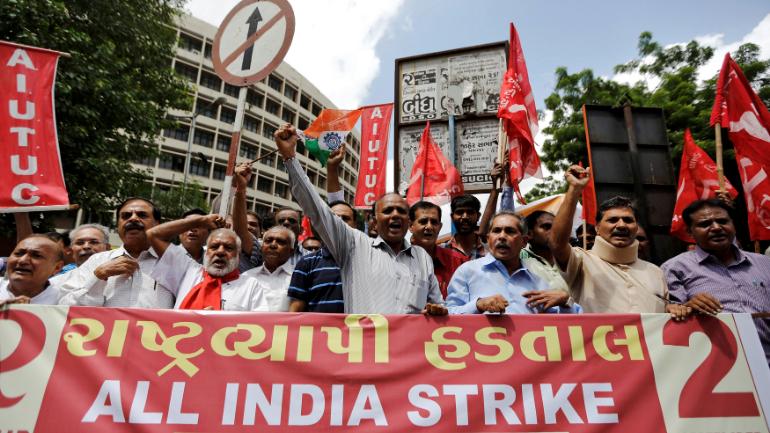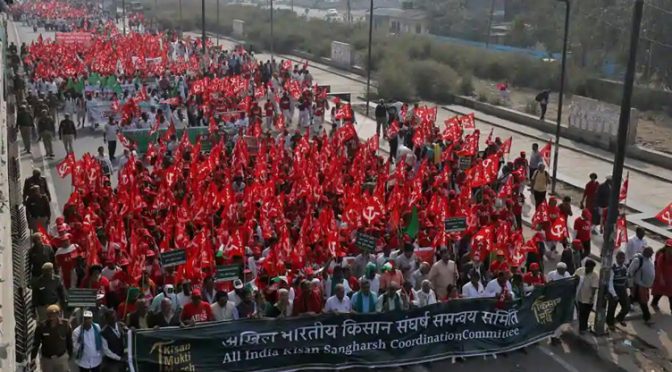
While the capitalist media largely tried to black-out the strike, it was supported by broad sections of the working class, both in the so-called formal and informal sectors. Moreover, the strike cut across the caste and communal divisions that the ruling capitalist class has used for decades to channel social discontent along reactionary lines.

Chief among those taking part in the stoppage were coal miners, postal workers and dockers, as well as bank, insurance, telecommunication, transport and tea estate workers. Workers from government-owned industries were joined by those from global companies like Bosch, Toyota, Volvo, CEAT, Crompton and Samsonite.
India:Trade unions claim success in two-day all-India strike
were numerous reports of violent clashes, sackings and arrests of striking workers. In several states, such as West Bengal and Tamil Nadu, public sector workers defied government threats of dismissals, pay cuts and other disciplinary retaliation.
The most significant conflict erupted at the Daikin air-conditioning plant in the Neemrana industrial hub of Rajasthan, where 12 workers were arrested yesterday on trumped-up charges of rioting and attempted murder, with similar charges against some 700 unnamed workers. This was after police and security guards attacked a rally of about 2,000 strikers, using lathis (heavy iron-tipped sticks), rubber-coated pellets and tear gas shells on Tuesday.
This repression occurred less than 70 kilometres from the Maruti Suzuki car assembly plant at Manesar, in the neighbouring state of Haryana, where 13 workers have been sentenced to life imprisonment on frame-up murder charges. The 13 are the target of a company-government witch hunt for leading strikes and a plant occupation in 2011–12 against sweatshop conditions and precarious contract jobs.
According to reports, the impact of the two-day strike was substantial in key states, including Haryana and Rajasthan, as well as Maharashtra and Goa in the west, Punjab in the north, Kerala, Karnataka and Tamil Nadu in the south and West Bengal and Odisha in the east.
Private hospital workers and workers from the “unorganised” sector, including in the beedi and construction industries, as well as in retail and distribution, joined the strike in many states.
In Kerala, both state-owned and private buses were off the road. Public bus services were stopped in Karnataka and Haryana, where the Gurgaon-Manesar industrial belt is located.
In Mumbai, India’s financial centre and second largest city, most banks and government offices were shut down and port operations were crippled. About 32,000 workers from the city’s public transport service continued an indefinite strike for the second day, demanding higher wages and better working conditions, in defiance of a government Essential Services Maintenance Act (ESMA) order outlawing the strike.
However, the trade unions did not mobilise some of the most important and powerful sections of the working class, such as railway workers. Airports continued to function, with little to any disruption. That reflected the political perspective of the union bureaucracies.
The strike was called by ten central unions and politically led by the Stalinist Communist Party of Indian (Marxist) or CPM. Among the unions were the CPM-affiliated Center of Indian Trade Unions (CITU) and the All India Trade Union Congress (AITUC), controlled by the other main Stalinist party, the Communist Party of India (CPI). They were joined by the Congress-led Indian National Trade Union Congress (INTUC) and the Labour Progressive Front (LPF), which is affiliated to the DMK, a right-wing party based in Tamil Nadu.
The Kerala state government, which is led by the CPM, encouraged participation. However, underscoring the pro-business nature of the Stalinist parties, it struck an agreement with the CITU to exempt passenger train services and the tourism sector, citing likely financial losses.
Likewise, the unions did not call out autoworkers in Oragadam, on the outskirts of Chennai, which has been dubbed the “Detroit of India” because major automakers have factories there.
Just last November, the unions shut down two-month-long strikes involving over 3,000 workers from three companies operating in Oragadam—Yamaha, Royal Enfield and Myoung Shin India Automotive—without meeting any of the workers’ major demands. In its deal with Yamaha, the CITU pledged “industrial peace” and a “freeze” on sit-in strikes.
By joining the two-day strike, millions of workers have demonstrated their mounting hostility to the pro-market measures imposed by successive governments since 1991, when the Indian elite set out to transform the country into a cheap labour platform for global corporations.
This is the 18th national strike led by the CITU since 1991. But all the central and state governments formed by the parties with which the unions have been allied, including Congress, regional parties like the DMK and the Stalinist CPM and CPI, have ruthlessly pursued the same “investor-friendly” policies. This includes CPM-led state governments in West Bengal, Tripura and Kerala.
India’s much-vaunted “rise” has provided gargantuan wealth to a tiny capitalist elite while condemning the vast majority of people to poverty and economic insecurity, in which any misfortune—from illness to a job loss—can push a family into the social abyss.
Whereas India counted only two billionaires in the mid-1990s, it now boasts about 130—the fourth largest concentration in the world. Meanwhile, more than 70 percent of the population struggles to survive on less than $2 per day. Modi routinely seeks to entice global investors by emphasising that wages in India are no more than a quarter those in China.
The BJP won office in 2014 by pledging to create jobs. This has proven a cruel hoax. A Center for Monitoring Indian Economy study released this week estimated the unemployment rate rose in December to 7.4 percent. If those who have disappeared from the labour force since September 2016 are counted, the true rate is almost 13 percent—that is, more than 50 million unemployed.
To pursue the great-power ambitions of the ruling class, India also has formed a “global strategic partnership” with US imperialism and dramatically increased military spending. With the fifth biggest military budget globally, India now spends two-and-a-half times more on its military than on providing health care to its 1.3 billion people.
Underscoring the government’s callous indifference to the concerns of working people, Finance Minister Arun Jaitley issued a tweet yesterday denouncing the strike. The multi-millionaire accused the “Left trade unions” of seeking “to manufacture a protest on non-existent issues.”
The two-day strike is a part of an emerging international upsurge of the working class, from the Yellow Vest protests in France against the Macron government to US teachers and autoworkers, and Sri Lankan plantation workers who are demanding a doubling of their wages.
All over the world, in their struggles, workers are coming up against the unions and so-called “Left” parties that once claimed to represent their interests. The Indian unions called the strike with the aim of containing the growing anger of the working people and rural toilers, and channelling it behind electoral manoeuvres to bring to office an alternative capitalist government, whether led by the big business Congress Party or regional and caste-based parties.



Nessun commento:
Posta un commento